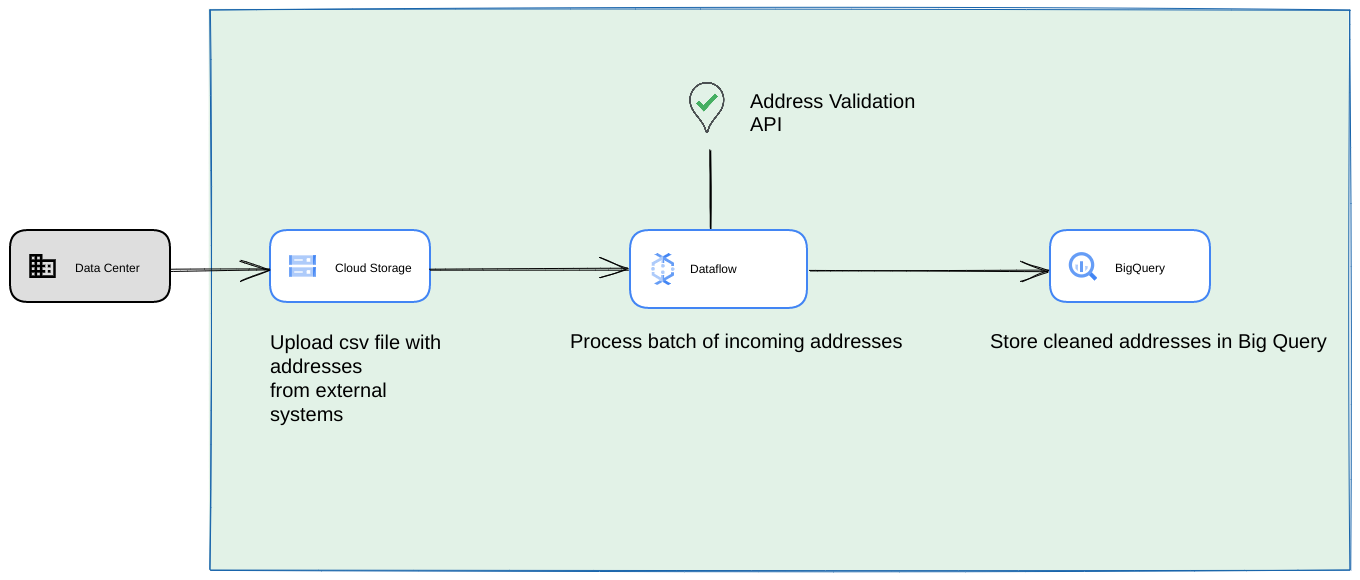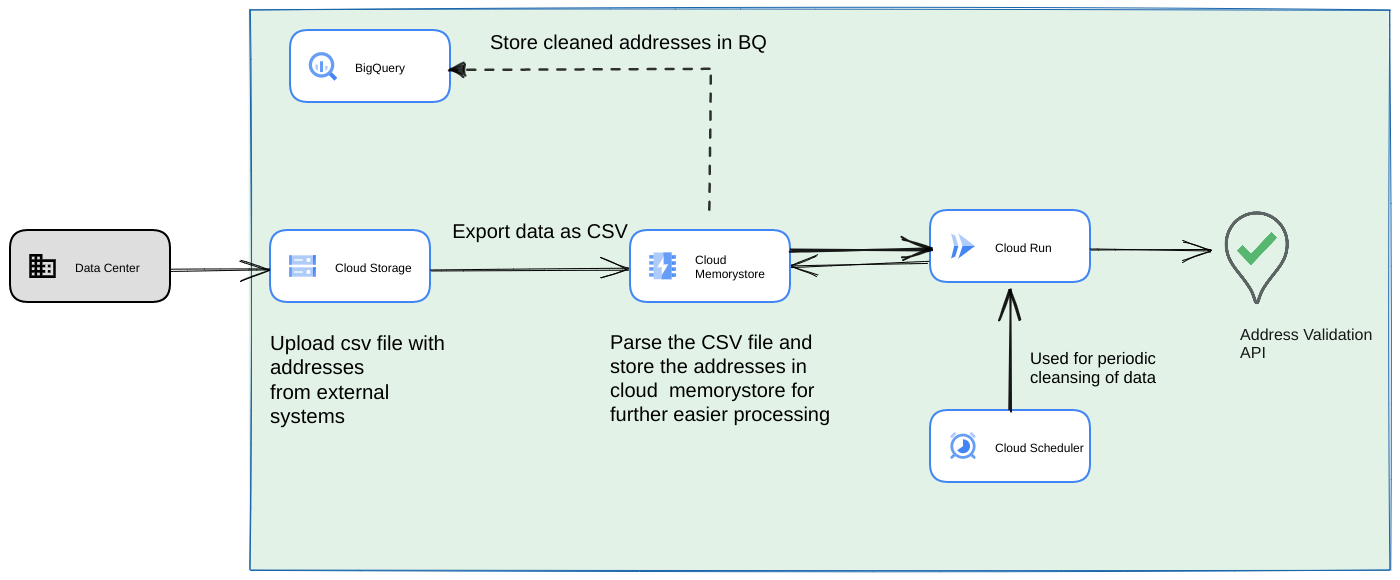目标
大批量地址验证教程介绍了可以使用大批量地址验证的不同场景。在本教程中,我们将向您介绍 Google Cloud Platform 中用于运行高容量地址验证的不同设计模式。
首先,我们将概述如何在 Google Cloud Platform 中使用 Cloud Run、Compute Engine 或 Google Kubernetes Engine 运行高容量地址验证,以进行一次性执行。然后,我们将了解如何将此功能纳入数据流水线中。
读完本文后,您应该能够很好地了解在 Google Cloud 环境中以高容量运行地址验证的不同选项。
Google Cloud Platform 上的参考架构
本部分将深入探讨使用 Google Cloud Platform 进行大批量地址验证的不同设计模式。通过在 Google Cloud Platform 上运行,您可以与现有流程和数据流水线集成。
在 Google Cloud Platform 上运行一次高容量地址验证
下图展示了如何在 Google Cloud Platform 上构建更适合一次性操作或测试的集成。
在这种情况下,我们建议您将 CSV 文件上传到 Cloud Storage 存储分区。然后,可以从 Cloud Run 环境运行高容量地址验证脚本。不过,您可以在任何其他运行时环境(例如 Compute Engine 或 Google Kubernetes Engine)中执行它。输出 CSV 还可以上传到 Cloud Storage 存储分区。
作为 Google Cloud Platform 数据管道运行
上一部分中显示的部署模式非常适合快速测试高容量地址验证,以供一次性使用。不过,如果您需要经常在数据流水线中使用它,那么可以更好地利用 Google Cloud Platform 原生功能来增强其稳健性。您可以进行的一些更改包括:

- 在这种情况下,您可以将 CSV 文件转储到 Cloud Storage 存储分区中。
- Dataflow 作业可以提取要处理的地址,然后将其缓存在 BigQuery 中。
- Dataflow Python 库可以扩展为具有大批量地址验证逻辑,以验证 Dataflow 作业中的地址。
从数据流水线运行脚本,作为长期运行的周期性进程
另一种常见方法是在流式数据流水线中验证一批地址,作为一种定期执行的流程。您可能还在 BigQuery 数据存储区中存储了地址。在此方法中,我们将了解如何构建需要每天/每周/每月触发的周期性数据流水线

- 将初始 CSV 文件上传到 Cloud Storage 存储分区。
- 使用 Memorystore 作为持久性数据存储区,以维护长时间运行的进程的中间状态。
- 将最终地址缓存在 BigQuery 数据存储区中。
- 设置 Cloud Scheduler 以定期运行脚本。
此架构具有以下优势:
- 借助 Cloud Scheduler,可以定期进行地址验证。您可能需要每月重新验证地址,或者每月/每季度验证所有新地址。此架构有助于解决该用例。
如果客户数据位于 BigQuery 中,则可以直接在其中缓存经过验证的地址或验证标志。 注意:大批量地址验证文章详细介绍了可以缓存的内容以及缓存方式
使用 Memorystore 可提高恢复能力,并能够处理更多地址。此步骤为整个处理流水线添加了状态,这对于处理非常大的地址数据集是必需的。您也可以在此处使用其他数据库技术,例如 Cloud SQL[https://cloud.google.com/sql] 或 Google Cloud Platform 提供的任何其他数据库类型。不过,我们认为 Memorystore 完美地平衡了扩缩和简易性需求,因此应该是首选。
总结
通过应用此处所述的模式,您可以在 Google Cloud Platform 上针对不同的用例使用地址验证 API。
我们编写了一个开源 Python 库,可帮助您开始使用上述应用场景。您可以从计算机上的命令行调用该工具,也可以从 Google Cloud Platform 或其他云服务提供商调用该工具。
如需详细了解如何使用该库,请参阅这篇文章。
后续步骤
下载通过可靠的地址提升结账、配送和运营效率 白皮书,并观看通过地址验证提升结账、配送和运营效率 网络研讨会。
建议的进一步阅读内容:
贡献者
Google 负责维护本文。以下贡献者最初撰写了此内容。
主要作者:
Henrik Valve | 解决方案工程师
Thomas Anglaret | 解决方案工程师
Sarthak Ganguly | 解决方案工程师


